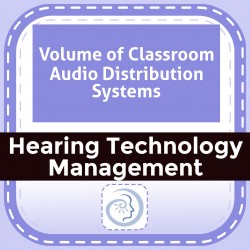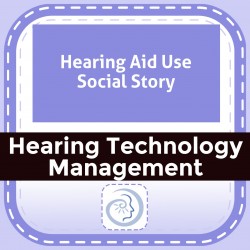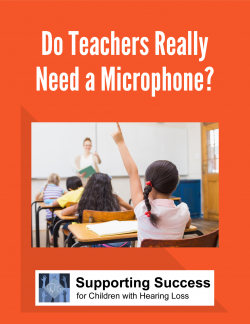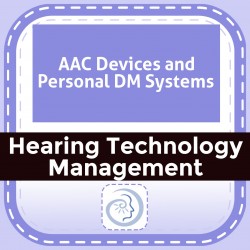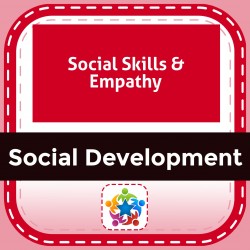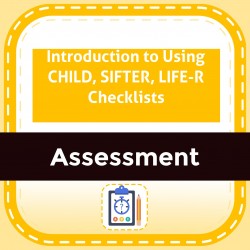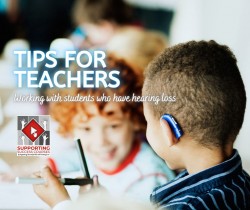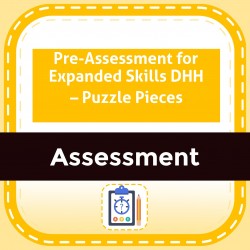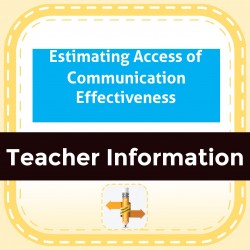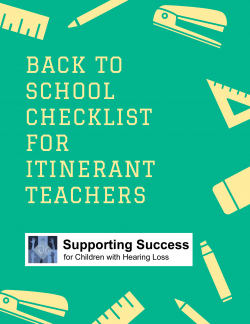Ability Levels
Categories
Resource Types
Age/Grade Range
CCSS
Anchor Standard
Speaking & Listening
Language
Reading
Volume of Classroom Audio Distribution Systems
$ 150
This information page describes the purpose of soundfield amplification systems, otherwise known as classroom audio distribution systems, and describes specifically how to appropriately set the volume
...
. It is common for classroom teachers to set CADS volume too high!
Hearing Aid Use Social Story
$ 175
This BoardmakerTM social story provides a clear example of how to address using hearing aids everyday and what to do if the hearing aid is not working.
Do Teachers Really Need a Microphone?
$ 150
Teachers who have not had experience with students who are hard of hearing are usually unused to wearing a microphone transmitter and often ask, "Do I really Need a Microphone?" This brief information
...
al article describes how hearing technologies are essential tools for learning.
AAC Devices and Personal DM Systems
$ 2
AAC devices were initially intended for individuals with adequate access to spoken language but a limited ability to express themselves. Now AAC devices are used for children with a full spectrum of c
...
ommunication abilities, including those who have hearing loss and/or severe receptive language delays. This handout provides information describing how different AAC devices can be integrated with a student's DM/FM device so that auditory access can be achieved.
Social Skills & Empathy
$ 225
Feeling empathy for another person is the ability to share or understand his or her feelings. This article discusses how children learn empathy and provides instructional strategies and activities for
...
teaching students to respond with appropriate empathy.
Introduction to Using CHILD, SIFTER, LIFE-R Checklists
$ 0
Descriptions by DHH specialists of commonly used checklists that have been a staple in providing support to students with hearing loss.
Tips for Teachers Working with Students who have Hearing Loss
$ 2595
Tips for Teachers consists of 10 videos, each only about 2 minutes in length, by educational audiologist Jim Bombicino. You can email links to share one tip at a time with one or more teachers. A grea
...
t way to remind classroom teachers of our students' auditory access needs! Choose which tips to send, or send one a week to kick off the school year. Tips topics include: facing the student, small group work, using the HAT system, moving around, etc. Incorporates simulations of challenges listening in a classroom with hearing devices. Comes with handouts about listening in background noise, 2 general inservice handouts, and emailable tips for teachers. The purchase price allows 50 downloads of each
video. Once you have purchased the series and selected email addresses
that will receive the links, you can view the videos on your device for a
limited time.Youtube Link: https://youtu.be/RNBZ71c1XtQ
Pre-Assessment for Expanded Skills DHH – Puzzle Pieces
$ 0
The source of the goals on this puzzle is Expanded Skills from RMTCDHH.org that were then inserted into an interesting puzzle piece format. You can use it as a pre-assessment at the beginning of the s
...
the school year to document what students know about their hearing loss and other necessary skills or use it as an ongoing data collection tool. Color in or click the button on the puzzle piece goal items students already know. Strike through or label those that do not apply as NA. Older students can review with teacher assistance and then color in the puzzle pieces. This pre-assessment provides a good visual for the breadth of learning accomplished and the goals that still need to be learned. In this way this functional pre-assessment can help decide what IEP goals and objectives to focus on and teach.
Estimating Access of Communication Effectiveness
$ 0
The opportunity to access to all classroom instruction and peer-to-peer communication is a key assumption of regular education and of 504, IDEA and Title II of the Americans with Disabilities Act (ADA
...
). A November 2014 policy guidance from the US Department of Education and US Department of Justice clarified that, under Title II of the ADA, schools are required to ensure that communication for students who are deaf and hard of hearing are as effective as communication for others through the provision of appropriate aids and services, thereby affording an equal opportunity to obtain the same result to gain the same benefit as that provided to others and to participate in and enjoy the benefits of the district’s services, programs, and activities . The ADA requirements restate the principles stated under Section 504, which is often seen as the means used to fulfill the requirements of ADA. Per the U.S. Department of Justice2 : Public entities must not discriminate against, deny the benefits of, or exclude qualified individuals with disabilities from participation in any service, program, or activity. The aids, benefits, and services provided to persons with disabilities must be equal to those provided to others, and must be as effective in affording equal opportunity to obtain the same results, to gain the same benefit, or reach the same level of achievement as those provided to others. These requirements apply to all school-related communication for children with known hearing, vision or expressive speech impairments, ages 3 through 22, who are educated in public schools, including charter and magnet schools
Back to School Checklist for Itinerant Teachers - fillable
$ 2
New to itinerant teaching or ready for more organization to the crazy start to the school year? The Back to School Checklist provides a step-by-step checklist to remind you of what is needed for each
...
of your students. It includes a template you can use to create a Teacher Letter for each student. Take this step to getting better organized!
 Your browser is out of date. For best experience switch to latest updated Browser.
Your browser is out of date. For best experience switch to latest updated Browser.
 Get Chrome
Get Chrome Get Edge
Get Edge Get Firefox
Get Firefox